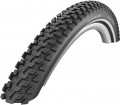Load
The maximum load that the tyre can carry in normal operating condition (installed and inflated to operating pressure). Usually, this parameter is given with some margin — adjusted for the fact that during the ride there may be short-term high loads that exceed the weight on the wheel during uniform movement. So if the load on the tyre is close to the maximum indicator, but does not exceed it, you don’t have to worry about the integrity of the tyres (of course, when using them as part of the assignment). Moreover, even with a significant excess of the permissible load (by 20 – 30 kg), the product most likely will not burst immediately. However, exceeding the load definitely cannot be allowed: with an increased load, the likelihood of a tyre “explosion” increases dramatically, and it is highest at high speed, on bumps and in sharp turns — that is, in the most traumatic situations.
When determining the load on each wheel, you need to determine the total mass of the bike and the rider, and also take into account that the rear wheel accounts for about 65% of the weight, the front wheel for about 35%. To simplify the calculations, if special accuracy is not required, you can take 2/3 of the weight for the rear wheel, and 1/3 for the front wheel. For example, if a person weighs 80 kg and a bicycle weighs 10 kg, then the total weight will be 90 kg, and the front wheel will have a load of approximately 30 kg, and the rear wheel will have a load of 60 kg. However, modern “a...dult” bicycle tyres for the most part have rather high maximum load rates — often 120 kg or more. So it makes sense to look closely at this indicator mainly in specific situations: if a bike is needed for a very large and massive person, if we are talking about a children's bike (“children's” tyres can have very limited load limits), or if you plan to carry heavy cargo. If we talk about cargo, then its weight is distributed over the wheels, depending on where the luggage is located. When placed on the rear (boot or “bicycle pants”) or front wheel (city bike basket), the weight is added to the load on the corresponding wheel, and if the cyclist carries a backpack, then the weight of the combined weight of the backpack and the person is distributed according to the proportion described above.
Cord
The material of the bead wires used in the tyre.
A beading cable is a rigid cable passed along the edge of the tyre (along that part of it that is in direct contact with the rim. It allows the tyre to maintain its shape and provides it with a snug fit to the rim. Such an element can be made from different materials:
—
Steel. A steel wire beading cable is a classic and most common option in modern models. This design is quite practical and at the same time inexpensive. It does not have some of the advantages of Kevlar (see below), but in most cases this is not critical.
—
Kevlar. Kevlar fibre is lighter than steel wire, resulting in an average weight gain of about 100 grams per tyre. It is this option, for a number of reasons, that is considered optimal for tubeless models (see below). In addition, it allows you to fold the tyre very compactly (literally “flatten” it) without losing performance. Therefore, models with such cables are sometimes also called "folding". However, they are much more expensive than tyres with traditional materials.
Puncture protection
The presence of additional
protection against punctures in the design of the tyre.
Such protection is a layer of special material (dense rubber, Kevlar, etc.) placed between the cord and the tread, thereby increasing the total thickness of the tyre from the outer part of the tread to the chamber. As a result, many small sharp objects (like a carnation or glass shard) that could pierce a normal tyre do not pose a danger to a protected model. Of course, this design does not give an absolute guarantee against punctures, moreover, the additional layer usually does not apply to the sidewalls; however, other things being equal, “protected” tyres are definitely more reliable than unprotected ones. Their unequivocal disadvantages include a higher cost, as well as a slightly greater weight.
Reflective strip
The presence of a reflective strip in the design of the tyre.
Such a strip is usually applied to the sides of the product. As the name suggests, it reflects light well — in particular, from car headlights. Thanks to this, when illuminated from the side, the tyres strongly “shine”, making the cyclist more visible on the road – and this is important when driving at night.
Weight
The total weight of the tyre.
This indicator affects the overall weight of the bike, but this influence is so insignificant that in most cases it can be neglected — especially since the difference between tyres similar in size and use can be some tens of grams, or even grams. In fact, paying attention to weight makes sense mainly when used in professional racing, where the struggle sometimes goes for tenths of a second — and, accordingly, every extra gram can be decisive. If tyres are bought for simpler use — for example, amateur "rides" on roads or even cross-country — this parameter can not be given much attention.

